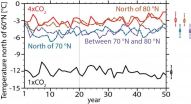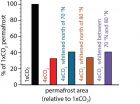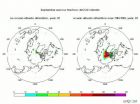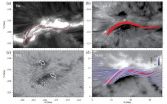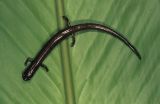(Press-News.org) Washington, D.C.-- Some scientists have suggested that global warming could melt frozen ground in the Arctic, releasing vast amounts of the potent greenhouse gas methane into the atmosphere, greatly amplifying global warming. It has been proposed that such disastrous climate effects could be offset by technological approaches, broadly called geoengineering. One geoengineering proposal is to artificially whiten the surface of the Arctic Ocean in order to increase the reflection of the Sun's energy into space and restore sea ice in the area.
New research from Carnegie's Ivana Cvijanovic (now at Lawrence Livermore National Laboratory) and Ken Caldeira, as well as Douglas MacMartin of Caltech, shows that while an incredibly large effort could, in principle, restore vast amounts of sea ice by this method, it would not result in substantial cooling. As a result, it would not be effective in keeping the ground frozen in the Arctic. Their findings are published by Environmental Research Letters.
"By the middle of the century, the Arctic Ocean is predicted to be ice-free during part of the year," lead author Cvijanovic explained. "This could create substantial ecological problems in the Arctic, including habitat range changes and loss of biodiversity."
Beyond this, it could also have devastating effects on human settlements of Arctic indigenous communities.
"However the problem is not only local--a number of studies have indicated that Arctic sea ice loss can affect weather patterns across the northern midlatitudes, including Europe, most of North America, and much of Asia," Cvijanovic added.
The technological feasibility of various Arctic whitening ideas is very much up in the air. Proposals include floating grains or microbubbles that would reduce the absorption of the Sun's rays. But beyond whether they are even feasible, it is important to determine whether or not they would have the desired environmental impact if they were implemented.
Using specially developed model configurations, the team studies how Arctic whitening would be expected to play out in a world with four times the preindustrial amount of atmospheric carbon dioxide , and an Arctic that is about 10 degrees Celsius hotter (18 degrees Fahrenheit).
They found that these sorts of whitening methods could restore some amount of sea ice--about three-quarters of a square kilometer of ice for every whitened square kilometer (or three-quarters of a square mile for every whitened square mile). However, the cooling achieved by ocean whitening is modest and appears unable to do very much to maintain permafrost and prevent the release of the greenhouse gas methane.
Another interesting finding is that ocean whitening and sea ice recovery is likely to affect the climate far outside the Arctic region.
"Ocean whitening and the sea ice recovery achieved in this way could lead to wetter and milder winter conditions in the southwestern United States and cooler conditions in the eastern United States," Cvijanovic explains.
"Simply put, our results indicate that whitening the surface of the Arctic Ocean would not be an effective tool for offsetting the effects of climate change caused by atmospheric greenhouse gas," Caldeira said. "Furthermore, it is not clear to me that there is a technologically feasible way of actually doing this, and even if you could do it, the direct negative consequences of reducing the amount of sunlight available to marine ecosystems could be huge."
The authors noted, however, that this sort of whitening approach could be effective on a smaller scale, perhaps in an individual bay or estuary, as opposed to a whole ocean.
INFORMATION:
The Carnegie Institution for Science is a private, nonprofit organization headquartered in Washington, D.C., with six research departments throughout the U.S. Since its founding in 1902, the Carnegie Institution has been a pioneering force in basic scientific research. Carnegie scientists are leaders in plant biology, developmental biology, astronomy, materials science, global ecology, and Earth and planetary science.
The Department of Global Ecology was established in 2002 to help build the scientific foundations for a sustainable future. The department is an independent research organization funded by the Carnegie Institution. Its scientists conduct basic research on a wide range of large-scale environmental issues, including climate change, ocean acidification, biological invasions, and changes in biodiversity. It is located on the campus of Stanford University.
Glenview, Ill., April 28, 2015--A study published on April 23 in the Online First section of the journal CHEST finds an elevated upper body position might improve respiratory safety in women early after childbirth without impairing sleep quality. Pregnancy-related maternal death occurs in 10 to 13 of 100,000 pregnancies and is attributable to anesthesia in 0.8 to 1.7 percent of the cases. A main cause of anesthesia-related maternal death is postpartum airway obstruction.
"Women who sleep with their upper bodies propped up 45 degrees in the days following childbirth can ...
Washington, DC, April 28, 2015 - Rates of infection with the deadly superbug Clostridium difficile were highest in the Northeast region of the country and in the spring season over the last 10 years, according to a study published in the May issue of the American Journal of Infection Control, the official publication of the Association for Professionals in Infection Control and Epidemiology (APIC).
Researchers from the University of Texas retrospectively analyzed 2.3 million cases of C. difficile infection (CDI) from 2001-2010 and found the highest incidence in the Northeast ...
University of Washington research shows that using a single category of learning disability to qualify students with written language challenges for special education services is not scientifically supported. Some students only have writing disabilities, but some have both reading and writing disabilities.
The study, published online in NeuroImage: Clinical, is among the first to identify structural white matter and functional gray matter differences in the brain between children with dyslexia and dysgraphia, and between those children and typical language learners.
The ...
ANN ARBOR -- In certain types of cancer, nerves and cancer cells enter an often lethal and intricate waltz where cancer cells and nerves move toward one another and eventually engage in such a way that the cancer cells enter the nerves.
The findings, appearing in Nature Communications, challenge conventional wisdom about perineural invasion, which holds that cancer cells are marauders that invade nerves through the path of least resistance, said Nisha D'Silva, principal investigator and professor at the University of Michigan School of Dentistry.
D'Silva's lab discovered ...
Scientists at NJIT's Big Bear Solar Observatory (BBSO) have captured the first high-resolution images of the flaring magnetic structures known as solar flux ropes at their point of origin in the Sun's chromosphere. Their research, published today in Nature Communications, provides new insights into the massive eruptions on the Sun's surface responsible for space weather.
Flux ropes are bundles of magnetic fields that together rotate and twist around a common axis, driven by motions in the photosphere, a high-density layer of the Sun's atmosphere below the solar corona ...
Species exchange between North and South America created one of the most biologically diverse regions on Earth. A new study by Smithsonian scientists and colleagues published this week in the Proceedings of the National Academy of Sciences shows that species migrations across the Isthmus of Panama began about 20 million years ago, some six times earlier than commonly assumed. These biological results corroborate advances in geology, rejecting the long-held assumption that the Isthmus is only about 3 million years old.
"Even organisms that need very specific conditions ...
In the midst of an international campaign to slow the spread of HIV in sub-Saharan Africa, the World Health Organization recommends male circumcision (the surgical removal of foreskin from the penis) which reduces HIV acquisition by 50-60%. However, scientists report that a new study of HIV-infected men in Uganda has identified a temporary, but potentially troublesome unintended consequence of the procedure: a possible increased risk of infecting female sexual partners while circumcision wounds heal.
In a study by researchers from the Johns Hopkins University School ...
The ability to move one's body rapidly through water is a key to existence for many species on this blue planet of ours. The Persian carpet flatworm, the cuttlefish and the black ghost knifefish look nothing like each other - their last common ancestor lived 550 million years ago, before the Cambrian period - but a new study uses a combination of computer simulations, a robotic fish and video footage of real fish to show that all three aquatic creatures have evolved to swim with elongated fins using the same mechanical motion that optimizes their speed, helping to ensure ...
The likelihood of viral shedding from male circumcision wounds intially increases, then decreases as the wounds heal, and is lower in patients with lower plasma viral load, according to a study published this week in PLOS Medicine. The study, conducted by Aaron Tobian, of Johns Hopkins University, Baltimore, MD and the Rakai Health Sciences Program, Entebbe, Uganda, and colleagues, monitored 223 HIV-infected men for wound healing and viral shedding from their surgical wounds for 12 weeks following voluntary medical male circumcision.
The researchers found that, compared ...
Data from southeast Asia -- where artemisinin-resistant malaria strains were first detected -- broadly support WHO's 'working definition' for artemisinin resistance, but the currently used definitions require important refinements, according to a study by Lisa White and colleagues, from Mahidol University in Bangkok, Thailand, published this week in PLOS Medicine.
The drug artemisinin rapidly clears malaria parasites from the blood of infected patients -- unless the parasites have developed resistance, in which case parasite clearance after artemisinin therapy (ACT) takes ...
